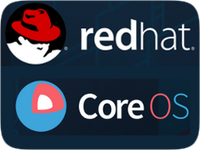For the last three years or so, Red Hat has been on a collision course with CoreOS, with both firms aiming to grow their respective Kubernetes platform. On Jan. 30, the competition between the two firms ended, with CoreOS agreeing to be acquired by Red Hat in a $250 million deal.
CoreOS didn’t start out as a Kubernetes platform vendor, but then again neither did Red Hat. CoreOS’s original innovations were the etcd distributed key value store, a purpose-built container Linux operating system  (originally known as CoreOS Linux), and the company’s Fleet platform that enabled Docker containers to easily be run as a cluster.
(originally known as CoreOS Linux), and the company’s Fleet platform that enabled Docker containers to easily be run as a cluster.
In a 2017 video interview with ServerWatch, CoreOS co-founder and CTO Brandon Philips explained why his company moved on from Fleet and embraced Kubernetes with its Tectonic platform.
Red Hat’s OpenShift platform was originally built based on technology acquired from Platform-as-a-Service vendor Makara in 2010. Red Hat entirely re-worked the platform for its 3.0 release in 2015, re-basing it on Docker and Kubernetes.
While Red Hat OpenShift and CoreOS Tectonic are both based on Kubernetes, they were highly competitive with each other. Though that’s not how Red Hat sees it.
“CoreOS’s existing commercial products are complementary to existing Red Hat solutions,” Matt Hicks, senior vice president, engineering, Red Hat, told ServerWatch. “Our specific plans and timeline around integrating products and migrating customers to any combined offerings will be determined over the coming months.”
How CoreOS Customers Will Benefit from the Acquisition
Hick said it is Red Hat’s belief that CoreOS customers will benefit from industry-leading container and Kubernetes solutions, a broad portfolio of enterprise open source software, world-class support, and an extended partner network.
CoreOS had been leading the development of the rkt container runtime, which is a rival to the Docker-backed containerd runtime. Red Hat has its own effort known as CRI-O, which is also based on containerd. CRI-O 1.0 was released in October 2017.
“rkt has a sustaining community within the Cloud Native Computing Foundation (CNCF), and that won’t change,” Hicks said. ” Red Hat and CoreOS are both committed to furthering the standardization of key container standards to further enterprise adoption, as evidenced by our leadership positions within OCI. Specific product-level decisions will come in the following weeks around future investments.”
Why Now?
Red Hat and CoreOS were actively competing against each other in the market. Red Hat CEO Jim Whitehurst has repeatedly made multiple comments in recent months about the financial success OpenShift has had.
“If you believe containerized applications will be kind of how applications are developed in the future, it will be a substantial opportunity,” Whitehurst said in September 2017. “There is a lot of value in [OpenShift], because it includes RHEL, it includes a fully supported life cycle for Kubernetes and a whole set of management tools, and then, obviously, above that a whole developer tool chain.”
Now, with CoreOS as part of Red Hat, the value in OpenShift can potentially be expanded even further. Hicks believes CoreOS can expand Red Hat’s technology leadership in containers and Kubernetes and enhance core platform capabilities in OpenShift, Red Hat Enterprise Linux and Red Hat’s integrated container portfolio.
“Bringing CoreOS’s technologies to the Red Hat portfolio can help us further automate and extend operational management capabilities for OpenShift administrators and drive greater ease of use for end users building and managing applications on our platform,” Hicks said.
Hicks added that CoreOS’s offerings complement Red Hat’s container solutions in a number of ways:
- Tectonic and its investment in the Kubernetes project that it is based on are complementary to Red Hat OpenShift and Red Hat’s own investments in Kubernetes. CoreOS can further extend Red Hat’s leadership and influence in the Kubernetes upstream community and also bring new enhancements to Red Hat OpenShift around automated operations and management.
- Container Linux and its investment in container-optimized Linux and automated “over the air” software updates are complementary to Red Hat Enterprise Linux, Red Hat Enterprise Linux Atomic Host and Red Hat’s integrated container runtime and platform management capabilities. While Red Hat Enterprise Linux’s content will remain the company’s only Linux offering, some of the delivery mechanisms pioneered by Container Linux will be reviewed by a joint integration team and reconciled with Atomic.
- Quay brings expanded registry capabilities that can both enhance OpenShift’s integrated registry component and the Red Hat Container Catalog and be used as a standalone component.
In the final analysis, with Red Hat’s acquisition of CoreOS, the big shift is that there is one less competitor in the Kubernetes landscape, and the biggest player just got bigger.
Sean Michael Kerner is a senior editor at ServerWatch and InternetNews.com. Follow him on Twitter @TechJournalist.

